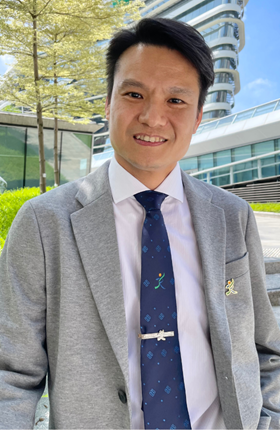Academic Staff


Dr Philip HO
Assistant Professor
PhD (HKU), MPhil (HKUST), BSc (Hons) (HKUST)
- ST507a
- +852 3400 8966
- philip-wl.ho@polyu.edu.hk
Biography
Dr Philip Ho completed Bachelor of Science in Biochemistry, and Master of Philosophy at the Hong Kong University of Science and Technology in 1997 and 1999, respectively. Afterward, Dr Ho obtained his Doctor of Philosophy degree in the Department of Medicine, University of Hong Kong in 2004. Before joining PolyU, Dr Ho received his postdoctoral fellowship and worked in a position as Research Assistant Professor and Scientific Officer in HKU.
Dr Ho’s research focuses on pre-clinical investigation of Parkinson’s disease and various related neurological disorders, including elucidation of the pathogenic mechanisms related to mitochondrial dysfunction and impaired autophagy associated with LRRK2 mutations using in vitro and in vivo experimental models to develop novel neuroprotective strategies. In addition to his in-house generated LRRK2 mutant mouse model, Dr Ho also started to develop PD patient-derived iPSCs as an alternative disease model. Moreover, Dr Ho is actively participating in collaborative research projects as principal investigator on environmental risks of chemicals of emerging concern in the State Key Laboratory of Marine Pollution (SKLMP, CityU). In particular, he has developed a novel human cell-based assay kit to assess level of estrogenicity induced by environmental xenoestrogens and various endocrine disruptive compounds. This novel assay has incorporated a novel patented protein tag as a major detection component of the assay kit. As a listed inventor, this invention is patented in US, Europe and China since 2015.
Dr Ho has published over 50 original research articles and invited reviews in prestigious peer-reviewed journals, including Autophagy, npj Parkinson’s disease, and Translational Neurodegeneration. Philip obtained a number of competitive research grants, including HMRF and RGC/GRF as PI/Co-I, and supervised research postgraduate students in experimental neuroscience. Furthermore, he is invited as review editor, editorial board member, and ad hoc reviewer of a number of peer-reviewed journals, including Nature Communications, Translational Neurodegeneration, Journal of Neurology, Brain and Behavior, and Frontiers in Molecular Neuroscience, demonstrating his active participation in research community services.
Education and Academic Qualifications
- Doctor of Philosophy, Dept of Medicine, The University of Hong Kong
- Master of Philosophy in Biochemistry, The Hong Kong University of Science and Technology
- Bachelor of Science in Biochemistry, The Hong Kong University of Science and Technology
Research Interests
Research Output
- PWL Ho*, LF Li, HF Liu, ZYK Choi, EES Chang, SYY Pang, Y Malki, CT Leung, MHW Kung, DB. Ramsden, SL Ho*. In vivo overexpression of synaptogyrin-3 (SYNGR3) promotes striatal synaptic dopamine uptake in LRRK2R1441G mutant mouse model of Parkinson’s disease. Brain and Behavior. 2023; 13:e2886. (*Corresponding author)
- PWL Ho*#, EES Chang#, CT Leung, HF Liu, Y Malki, SYY Pang, ZYK Choi, Y Liang, WS Lai, Y Ruan, KMY Leung, S Yung, JCW Mak, MHW Kung, DB. Ramsden, SL Ho*. Long-term inhibition of mutant LRRK2 hyper-kinase activity reduced mouse brain α-synuclein oligomers without adverse effects. npj Parkinson’s disease. 2022; 8:115. (*Co-corresponding author)
- Li L#, Ho PWL#, Liu HF, Pang SYY, Chang EES, Choi ZYK, Malki Y, MHW Kung, Ramsden DB, Ho SL*. Transcriptional Regulation of the Synaptic Vesicle Protein Synaptogyrin-3 (SYNGR3) Gene: The Effects of NURR1 on Its Expression. International Journal of Molecular Sciences 2022; 23(7):3646. (#Joint first-author).
- Chang EES, Ho PWL*, Liu HF, Pang SYY, Leung CT, Malki Y, Choi ZYK, Ramsden DB, Ho SL*. LRRK2 mutant knock-in mouse models: therapeutic relevance in Parkinson's disease. Translational Neurodegeneration 2022; 11:10. (*Co-corresponding author).
- Liu HF#, Ho PWL#, Leung CT, Pang SY, Chang EES, Choi ZYK, Kung MHW, Ramsden DB, Ho SL*. Aberrant mitochondrial morphology and function associated with impaired mitophagy and DNM1L/ERK signaling are found in aged mutant Parkinsonian LRRK2R1441G mice. Autophagy2021; 17(10):3196-3220. (#Joint first-author).
- Ho PWL, Leung GC, Liu HF, Pang SY, Lam CS, Xian JW, Li LF, Kung MHW, Ramsden DB, Ho SL*.Age-dependent accumulation of oligomeric a-synuclein from impaired degradation in mutant LRRK2 knockin mouse model of Parkinson disease: role for therapeutic activation of chaperone-mediated autophagy (CMA). Autophagy 2020; 16(2):347-370.
- Human Catechol-O-methyltransferase (COMT) Assay [European Patent Office (EPO): EP2328909A1] - Listed inventor
- Human Catechol-O-methyltransferase (COMT) Assay [United State Patent & Trademark Office (USPTO): US20100081147A1] - Listed inventor
- Human Catechol-O-methyltransferase (COMT) Assay [China Cooperation Treaty (PCT): CN102203119A] - Listed inventor



